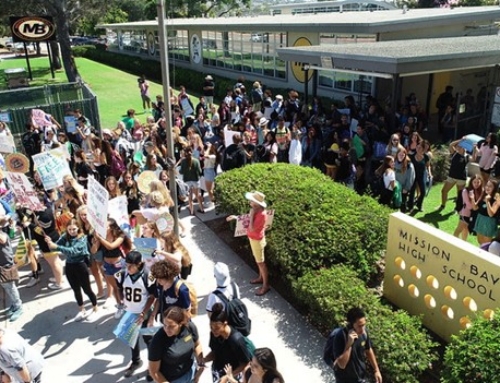The STAY COOL Advisory Council, under the leadership of Chair Bob Leiter and Linda Pratt, submitted the below letter to the San Diego County Board of Supervisors for consideration at their Feb. 14 meeting on the County Climate Action Plan.
Voices in support of a more proactive Climate Action Plan are needed at the Feb. 14 public hearing. Attend the following meeting to share your comment in person:
Date: February 14, 2018
Time: 9:00 a.m.
Location: Board of Supervisors North Chamber
1600 Pacific Highway, 3rd floor, San Diego, CA 92101
Click here to learn more about the meeting or to send an email in regards to the Climate Action Plan.
STAY COOL’s letter to the San Diego County Board of Supervisors:
February 9, 2018
Kristin Gaspar, Chairperson
San Diego County Board of Supervisors
1600 Pacific Highway, Room 331
San Diego CA 92101
RE: Climate Action Plan (Item 1, February 14, 2018)
Dear Chairperson Gaspar and Board Members:
STAY COOL for Grandkids (SC4G) appreciates the opportunity to provide comments to the San Diego County Board of Supervisors on the final draft County of San Diego Climate Action Plan (CAP), General Plan Amendment (GPA), and Draft Supplemental Environmental Impact Report (DSEIR), and other associated documents, which you are considering at your meeting on February 14, 2018. SC4G is a non-profit organization of volunteer grandparents, elders and other citizens in the San Diego region dedicated to preserving a livable climate in the name of those too young to have a voice: our future generations. Along with other partner organizations in our region, we advocate for meaningful action on climate change and support policies that will have a lasting effect by reducing Greenhouse Gas emissions and protecting our quality of life.
Why It’s Important for the County to Adopt an Ambitious and Effective CAP
We believe that it is unconscionable for any of us to leave the burden of mitigating and adapting to climate change on the shoulders of young people. By continuing to delay significant reductions in greenhouse gas emissions, we increase the likelihood of severe health impacts, food and water scarcity, and untold degradation of the quality of life for future generations. Additionally, we risk handing young people alive today a bill of up to US$535 trillion. This would be the cost of the “negative emissions” technologies required to remove atmospheric CO₂ to avoid dangerous climate change. (Young people’s burden: requirement of negative CO2 emissions, James Hansen, et al, Journal of Earth System Dynamics, 18 July 2017.) Intergenerational equity is the heart of the lawsuit Juliana v. United States. The 21 plaintiffs, ranging in age from 10 to 20 years old, state that the federal government’s refusal to take serious action against climate change unlawfully puts the well-being of current generations ahead of future generations. So far, the courts agree. In November 2017 the Ninth Circuit Court of Appeals allowed the suit to go to trial. Judge Ann Aiken set a judicial precedent in her decision, ruling that climate change may pose an unconstitutional burden on younger generations.
We believe that the County Board of Supervisors has the opportunity and the obligation to support a robust Climate Action Plan with a measurable and accountable implementation strategy. There are nearly 750,000 children under the age of 18 currently living in the County who are depending on us. There is no time to delay.
Major Comments and Concerns Regarding Final Draft CAP
We feel that many of the proposed strategies and measures that are identified in the draft CAP will be effective in reducing GHG emissions in the unincorporated areas within San Diego County, as well as reducing GHG emissions associated with County operations. However, we do not feel that the final draft CAP documents respond adequately to several concerns that SC4G and other stakeholder groups have raised previously.
The following are our major remaining comments and concerns on the final draft CAP.
#1 The final CAP should include additional “Built Environment and Transportation” GHG reduction measures.
According to the Planning Commission staff report, “The County has limited options under its control for implementing transportation-based strategies and relies heavily on energy-based solutions to meet the County’s commitments.” We strongly disagree with this statement, in that the County has direct control over land use and local transportation system planning within the unincorporated area. Specifically, there is no measure to specifically reduce vehicle miles traveled in newly planned residential development. According to the California Air Resources Board 2017 Scoping Plan, “CARB staff is more convinced than ever that, in addition to achieving GHG reductions from cleaner fuels and vehicles, California must also reduce VMT.” Yet despite of this imperative, the CAP provides a path for compliance for development in remote locations, which have intrinsically high vehicle miles traveled VMTs. Unless properly mitigated, these high VMTs will be permanent and ongoing and will undermine all other County efforts.
Our specific concerns and recommendations regarding this issue include the following:
- On p. 3-14, GHG Reduction Measure T-1.3 (Updating Community Plans) appears to be a feasible measure, but clearer performance metrics are needed. The proposed performance metric (“update of 19 community plans”) is not sufficient; a section should be added to identify what criteria the County will apply to the community plan updates in order to ensure that the plans are leading to measurable GHG reductions. In addition, the County should allocate adequate resources to expedite the completion of all 19 community plan updates; the proposed measure assumes that nearly half of the updates would not be completed until after 2030.
- On p. 3-18, GHG Reduction Measure T-2.1 (Improve Roadway Segments as Multi-modal) should include a better explanation for how the County will integrate this with other CAP measures (e.g., Update Community Plans) and the adopted Regional Transportation Plan / Sustainable Communities Strategy, and how the prioritization for improvements can best implement the measure effectively. In addition, the County should commit to pursuing funding from all available funding sources, including available SB 1 funding, to plan and construct “Complete Street” projects in suitable locations throughout the unincorporated area. The County should also commit to identifying suitable locations for “Green Street” projects, which combine the multi-modal aspects of “Complete Streets” with stormwater treatment and storm water re-use components that could qualify these projects for funding through Proposition 1 grants and other external funding sources that are intended to support local projects that improve water management.
- On p. 3-20, GHG Reduction Measure T-2.2 (Reduce New Non-residential Development Vehicle Miles Traveled) proposes to reduce commuter VMT in new non-residential development in the unincorporated County by 15% by 2030. It is our understanding that the County would implement this measure by adopting a Transportation Demand Management (TDM) ordinance that would apply to all new non-residential development. However, the draft CAP does not explain how the County would monitor the effectiveness of this measure; this should be clarified. Also, it is not clear why the County is not also recommending a similar measure for new residential development in the unincorporated County. There are a variety of feasible means by which the County could require developers of new residential and mixed-use development projects to reduce VMT associated with their projects. We would strongly recommend that the County consider such measures, which would likely lead to significant additional GHG reductions in the “Built Environment and Transportation” category.
#2 The County should reduce its reliance on a Direct Investment Program and should clarify how this program will be properly implemented.
On pp. 3-40 and 3-41, the CAP sets forth proposed GHG Reduction Measure T-4.1 (Establish a Direct Investment Program). It appears from the description of this measure that the County would allow “offsite” mitigation not only through “direct investment” credits from within San Diego County but also from any approved carbon credit providers outside of San Diego County. While the CAP suggests that all onsite mitigation measures would be applied before direct investment credits are used, the CAP provides no limits to how much offsite mitigation could be used. We have serious concerns regarding whether this option might undercut other feasible local GHG reduction measures, which could offer significantly greater co-benefits to the communities that they serve.
Furthermore, according to the preliminary assessment of the Direct Investment Program (Attachments H3 and H4 to County Planning Commission staff report), we understand that there are potential projects in the unincorporated area that could align with existing carbon credit protocols and which have the capacity to reduce GHG emissions. However, the County would still need to set these up and make sure they are properly funded and implemented, which is highly uncertain and could require significant County staff resources.
We are also still concerned that this measure is listed in the category of “Built Environment and Transportation,” the measure itself is not limited to projects that are directly related to GHG reductions in this category. As a result, the CAP document overstates the actual amount of GHG reductions from this category that are likely to occur.
#3 The final CAP should include an analysis that demonstrates that its GHG reduction strategies and measures are consistent with the adopted Regional Transportation Plan / Sustainable Communities Strategy (RTP / SCS) and other state and regional policies and plans.
We are still not clear from reviewing the draft CAP documents how the County is differentiating the GHG reductions that will be obtained as a result of its proposed “Built Environment and Transportation” GHG reduction measures from those transportation and land use planning factors that have already been assumed for the unincorporated portion of the County in the growth forecasts that were used by SANDAG in conducting its regional GHG reduction analysis for the adopted RTP / SCS. It is important to ensure that the County and SANDAG are taking a coordinated approach to helping the San Diego region meet its SB 375 GHG reduction targets, and that the County’s proposed reduction measures are not simply a duplication of land use and transportation factors that are already assumed in the RTP/SCS. We would request that the final CAP documents specifically address these concerns.
#4 The final CAP should provide a better explanation for how future General Plan Amendments will be evaluated in relation to the adopted CAP.
For example, we are not clear from our review of the draft CAP documents how the County will ensure that any future County General Plan amendments will not conflict with land use and transportation factors and/or assumptions for the unincorporated area that were used as the basis for the adopted CAP, and which were relied upon in SANDAG’s regional GHG reduction analysis in its adopted RTP / SCS. We would request that the final CAP documents address this issue more clearly.
#5 The final CAP should include a firm commitment to the goal of 100% renewable electricity by 2030, and it should also lay out the specific actions that the County will take to achieve this goal along with a specific timeline for taking these actions.
The Planning Commission agreed that the draft CAP’s goal of 90% renewable electricity by 2030 should be increased to 100%, and we support this recommendation. (see GHG Reduction Measure E-2.1) However, we see no indication of actions on the part of the County to set meaningful milestones that would ensure that the 100% renewable energy is achieved. We feel that it is critically important for the County to lay out an overall strategy and schedule for achieving this goal as quickly as possible, and that it commit to begin implementing this strategy immediately.
#6 The final CAP should specifically address Social Equity issues and should contain specific commitments by the County to address these issues.
One of the key findings of the recently published San Diego Region Climate Action Plan Report Card https://www.climateactioncampaign.org/reportcard2017/ is that “The Region Needs Action on Social Equity.” As discussed by the Climate Action Campaign (CAC) staff in this report, “Climate change does not affect all communities equally. Low-income communities of color are being hit first and worst by climate change because of a history of segregated housing, underinvestment in communities of color, and institutional racism that allowed toxic waste facilities and other hazards to disproportionately burden those communities. These impacts were not created by accident, and climate planning and policies need to be intentional about undoing them.” CAC reviewed all of the existing local government Climate Action Plans in the San Diego region, and found that “four cities – San Diego, Encinitas, San Marcos, and National City – address social equity in their CAPs. San Diego and Encinitas call for the development of equity metrics and methods to track and report on equity in implementation.”
We would strongly recommend that the County include a chapter on Social Equity in its final CAP, and that the CAP identify specific implementable actions to address social equity concerns, like the approaches taken by the cities of San Diego, Encinitas, San Marcos and National City. In addition, the County should take advantage of the full range of tools available to identify communities that shoulder a disproportionate pollution burden and are most vulnerable to the impacts of climate change, including CalEnviroScreen 3.0, the Healthy Places Index, and the criteria used for San Diego Integrated Regional Water Management Disadvantaged Community Planning Grants.
#7 The County should conduct further cost-benefit analysis of the proposed measures contained in the final draft CAP prior to removing measures that may raise concerns about housing affordability and economic competitiveness.
During the Planning Commission hearing, the Commissioners received testimony from the San Diego chapters of the Building Industry Association (BIA) and Commercial Real Estate Development Association (NAIOP) regarding the potential negative impacts of certain proposed GHG reduction measures on housing affordability and economic competitiveness. Based on this testimony, several of the Commissioners expressed their concerns regarding these issues, and the final Planning Commission recommendation included the removal or modification of these measures.
While we strongly support the goals of improving housing affordability and economic competitiveness in the San Diego region, we would like to see the County conduct a thorough and objective analysis of these issues. Such an analysis should include the actual projected impacts of the CAP on housing affordability and economic growth. At the same time, this analysis should include an evaluation of the potential benefits of the CAP on the regional economy, including housing, jobs and other economic factors. In this way, the County Board of Supervisors would get a better understanding of the potential costs and benefits of its proposed CAP and could make better informed decisions.
Conclusions
We appreciate the opportunity to have participated in the County’s CAP planning process, including the review of the previous draft CAP documents, and we hope that our remaining comments and concerns as set forth above will be given due consideration by the Board of Supervisors.
We also wish to note that we have worked collaboratively with other stakeholder organizations, including Endangered Habitats League, Southwest Wetlands Interpretive Association, and Climate Action Campaign over the past few weeks in our review of the latest draft CAP documents, and we support the written comments that these organizations have submitted to you.
Please feel free to contact STAY COOL Advisory Council members Bob Leiter at rleiter9@cox.net or Linda Pratt at lgpratt@sbcglobal.net if you have specific questions regarding the comments contained in this letter.
Best regards,
Bob Leiter
STAY COOL for Grandkids – Advisory Council Chair



